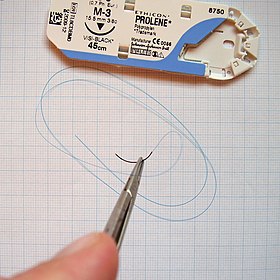
Back خيط جراحي Arabic Хирургически шев Bulgarian Sutura quirúrgica Catalan Sutura (medicína) Czech Pwyth llawfeddygol Welsh Nähen (Medizin) German Kirurgia kudrado Esperanto Sutura (medicina) Spanish Sutura Basque بخیه Persian
| Surgical suture | |
|---|---|
 Surgical suture and 6-0 gauge polypropylene thread held with a needle holder. Packaging shown above. |
A surgical suture, also known as a stitch or stitches, is a medical device used to hold body tissues together and approximate wound edges after an injury or surgery. Application generally involves using a needle with an attached length of thread. There are numerous types of suture which differ by needle shape and size as well as thread material and characteristics. Selection of surgical suture should be determined by the characteristics and location of the wound or the specific body tissues being approximated.[1]
In selecting the needle, thread, and suturing technique to use for a specific patient, a medical care provider must consider the tensile strength of the specific suture thread needed to efficiently hold the tissues together depending on the mechanical and shear forces acting on the wound as well as the thickness of the tissue being approximated. One must also consider the elasticity of the thread and ability to adapt to different tissues, as well as the memory of the thread material which lends to ease of use for the operator. Different suture characteristics lend way to differing degrees of tissue reaction and the operator must select a suture that minimizes the tissue reaction while still keeping with appropriate tensile strength.[2]
- ^ Byrne, Miriam; Aly, Al (2019-03-14). "The Surgical Suture". Aesthetic Surgery Journal. 39 (Supp. 2): S67–S72. doi:10.1093/asj/sjz036. ISSN 1090-820X. PMID 30869751.
- ^ Jeffrey M. Sutton; et al., eds. (2018). The Mont Reid surgical handbook. Philadelphia, PA. pp. 81–90. ISBN 978-0-323-53174-0. OCLC 1006511397.
{{cite book}}: CS1 maint: location missing publisher (link)
© MMXXIII Rich X Search. We shall prevail. All rights reserved. Rich X Search